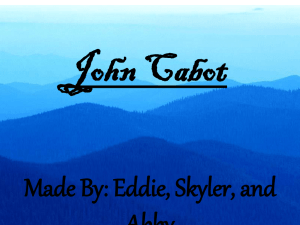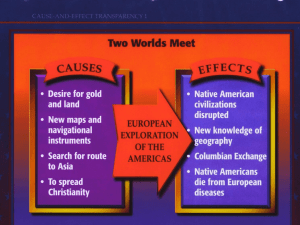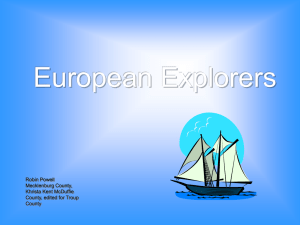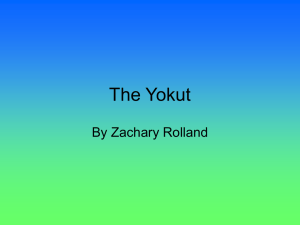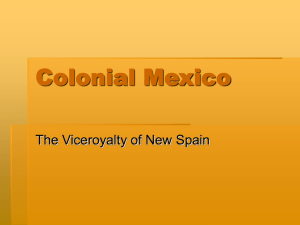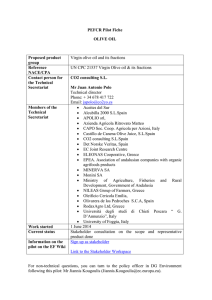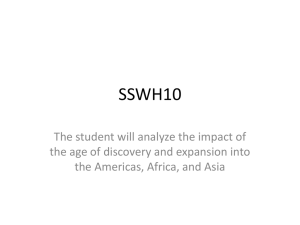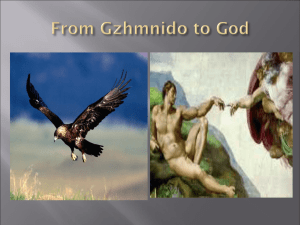Review 1st Nine Weeks
advertisement
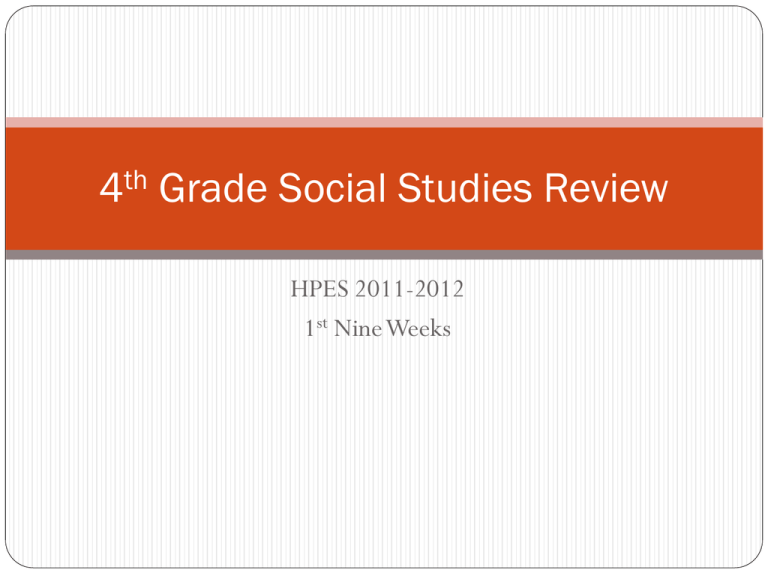
4th Grade Social Studies Review HPES 2011-2012 1st Nine Weeks What was the name of the period that described how the early people migrated from Asia to Americas? A. The Glacier Age B. The Ice Age C. The Prehistoric Age D. The Beringia Age What is one theory about how early people migrated from Asia to Americas? A. They walked across a land bridge. B. They came with Columbus. C. To show the people of Beringia the way to North America. D. To get away from wooly mammoths. Bases on historians, which theory caused the land bridge? A. Early people created roads B. Glaciers combined and flattened out to create land. C. Glaciers caused water level in ocean to drop and exposed land created a long land bridge. D. The low tide of the Pacific Ocean created beaches. What Native American group relied heavily on the buffalo for most of their needs? A. Great Basin B. Eastern Woodlands C. Plains D. Pacific Northwest Which Native American group used totem poles to identify clans and tell stories? A. Southwest B. Eastern Woodlands C. Plains D. Pacific Northwest Which Native American group grew vegetables such as corn, beans, and squash? A. Southwest B. Eastern Woodlands C. Plains D. Pacific Northwest How were lodges and teepees different? A. A lodge is for many people and a teepee is only for one person B. A lodge is used for women and children and a teepee is for men C. A lodge is made from buffalo hide and a teepee is made from wood D. A lodge is a permanent building and a teepee is made from animal hides and can be moved around. How were a potlatch and a totem pole similar? A. Both were a way to show wealth B. Both were considered gifts from parents C. Both were ceremonies in which people asked for rain D. Both were ceremonies in which people were healed from sickness Which of the following is NOT true? A. Native Americans developed ways of living based on their environments. B. The Southwest Desert Native American used irrigation to grow corn and other crops. C. The Great Plains Native Americans often used disguises to approach buffalo hers without being seen. D. The Eastern Woodlands Native Americans attended ceremonial dances to bring rain to the region. _____________lived in the eastern part of North America from the Atlantic Ocean to the Mississippi River, including the Great Lakes region. They used the forest resources, hunted for animals, created the moccasins, live in longhouses, and grew crops. _______________lived on the Great Plains of central North America from north of what is today the Canadian border to present-day southern Texas. _________________lived in the region that included what is today Arizona, New Mexico, parts of Colorado, and Utah. ___________Native Americans lived in the region that extended along the Pacific coast from what is today southern Alaska to northern California. Followed a hunting and farming life, always traveling, settled along river, lived in lodges and teepees, made baskets, used horses like money. Used canoes, made carvings, hunted seal, fishermen and hunters, lived in log houses. Used an irrigation system, grew corn, beans, and squash, men were weavers, women weaved and made baskets, lived in pueblos. Rain dances, snake dances, and kachinas. Men governed villages and women owned properties. Potlatch, totem poles, shamans, dancing ceremonies, sought power through dreams, had birth and death ceremonies. The ____________ Native Americans had a deep connection to animals, and gave thanks at harvest time. The members of the Great Council made all the rules. The ____________region is extremely arid. This region is located between the Rocky and Sierra mountains. One unique characteristic of this region is that all of the water flows to streams and rivers. There is no water outlet to the sea. Hunters and gatherers, ground acorns into flour to make mush, ate nuts and berries, women and children trapped small animals, women mostly prepared food, in summer lived in dome-shaped structures. o Shamans o Had ceremonies honoring pine nuts. o Each family had a headman by consensus. Which of the following was not a technological factor that led to exploration? A. The invention of the compass B. The skill of cartography producing better maps for explorers C. Spain becoming the most powerful nation and England wanting some of their power D. The invention of the astrolabe Which of the following is a political factor that encouraged exploration? A. Christopher Columbus wanted to run for President of Spain B. England and Spain wanted to overtake the Netherlands by sending explorers to their country C. Ferdinand Magellan not completing his trip around the world D. Spain becoming the most powerful nation and English Monarchs wanting their nation to be the most powerful Which of the following is an economic factor that encouraged exploration? A. Christopher Columbus wrecking his ship and needing to borrow more money from Spain B. England wanting to become the most dominant country C. Spain finding all the gold and silver, therefore becoming the most dominant country D. Europeans wanting to have more goods from the Far East, but not wanting to have to deal with merchants Merchants sold the goods they brought back from the Far East to the Europeans. They sold them for a higher price. What is this called? A. Trading B. Bartering C. Profit D. exploration Who discovered the Mississippi River? A. Hernando de Soto B. John Cabot C. Robert LaSalle D. Henry Hudson Which explorer explored for both England and the Netherlands? A. Hernando de Soto B. Henry Hudson C. John Cabot D. Robert LaSalle Which explorer was known as a conquistador? A. Hernando de Soto B. Henry Hudson C. John Cabot D. Robert LaSalle Who was the first explorer to discover North America? A. Erick the Red B. Christopher Columbus C. Leif Eriksson D. John Cabot What did John Cabot and Henry Hudson have in common? A. They only explored for one country. B. They were both looking for the Northwest Passage. C. They both disliked Spanish Explorers. D. Robert LaSalle was their long-lost cousin. Christopher Columbus was actually looking for the Far East but he found which continent instead? A. North America B. Asia C. Europe D. Australia In what year did Christopher Columbus find this continent? A. 1400 B. 1492 C. 1792 D. 1992 There were ___________, ___________, and _________ factors that led to the exploration of the new world by Spain, Portugal, France, the Netherlands, and England. List examples of these factors that led to the exploration of the New World. 1. 2. 3. o Had Pow Pows o groom’s father wove robes for bride and bride’s family wove baskets for groom o has ceremonies o has no written language
